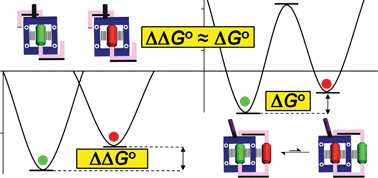Thermodynamic forecasting of mechanically interlocked switches†
Abstract
Mechanically interlocked molecular (MIM) switches in the form of bistable

* Corresponding authors
a
Department of Chemistry, Northwestern University, 2145 Sheridan Road, Evanston, IL, USA)
E-mail:
stoddart@northwestern.edu
Fax: +1-847-491-1009
Tel: +1-847-491-3793
b Organic Nanomaterials Center, National Institute for Materials Science, 1-1 Namiki, Tsukuba, Japan
c School of Chemistry, University of St. Andrews, Purdie Bulding, St. Andrews, Fife, UK
d Department of Chemistry and Biochemistry, University of California, Los Angeles, 405 Hilgard Avenue, Los Angeles, CA, USA
Mechanically interlocked molecular (MIM) switches in the form of bistable

 Please wait while we load your content...
Something went wrong. Try again?
Please wait while we load your content...
Something went wrong. Try again?
M. A. Olson, A. B. Braunschweig, T. Ikeda, L. Fang, A. Trabolsi, A. M. Z. Slawin, S. I. Khan and J. F. Stoddart, Org. Biomol. Chem., 2009, 7, 4391 DOI: 10.1039/B911874H
To request permission to reproduce material from this article, please go to the Copyright Clearance Center request page.
If you are an author contributing to an RSC publication, you do not need to request permission provided correct acknowledgement is given.
If you are the author of this article, you do not need to request permission to reproduce figures and diagrams provided correct acknowledgement is given. If you want to reproduce the whole article in a third-party publication (excluding your thesis/dissertation for which permission is not required) please go to the Copyright Clearance Center request page.
Read more about how to correctly acknowledge RSC content.
 Fetching data from CrossRef.
Fetching data from CrossRef.
This may take some time to load.
Loading related content
